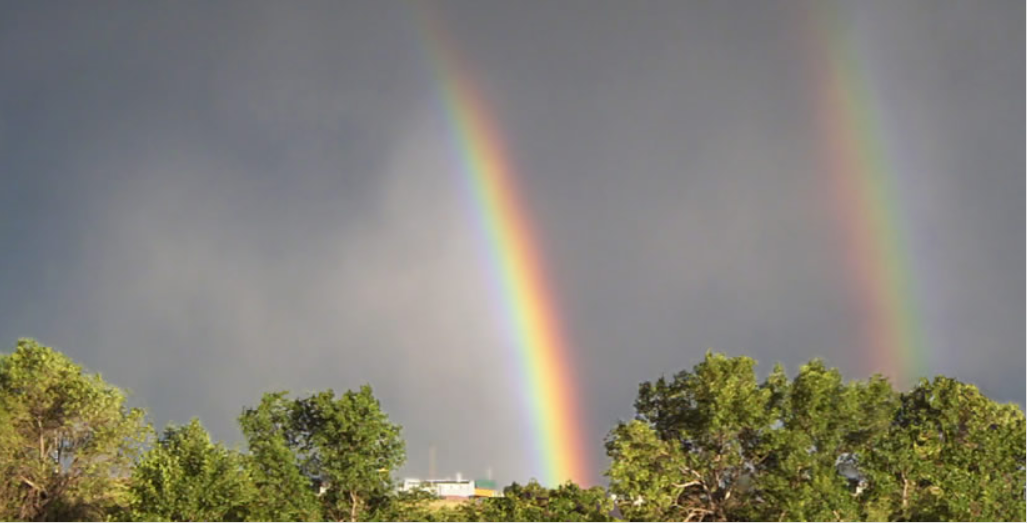Secondary Rainbow
The Phenomenon of the Secondary Rainbow
When we think of rainbows, the image that typically comes to mind is a vibrant arc of colors stretching across the sky. But did you know that there is more to rainbows than meets the eye? In addition to the primary rainbow, there is also a secondary rainbow that can sometimes be observed. The secondary rainbow is a fascinating optical phenomenon that occurs when light is reflected more than once inside a raindrop. In this article, we will delve into the details of the secondary rainbow and explore its unique characteristics.
The Characteristics of the Secondary Rainbow
The secondary rainbow is distinct from the primary rainbow in several ways. Here are some key features that differentiate the two:
-
Location: The secondary rainbow is positioned outside the primary rainbow and has a radius of approximately 51 degrees. It lies about 9 degrees beyond the primary bow.
-
Width: The secondary rainbow appears broader than the primary rainbow, measuring approximately 1.8 times its width. This increased width contributes to its distinct appearance in the sky.
-
Color Reversal: One of the most notable characteristics of the secondary rainbow is the reversal of colors compared to the primary rainbow. The reds of the two bows always face each other, creating a visually striking effect.
-
Brightness: While the primary rainbow is typically brighter, the secondary rainbow possesses only 43% of the total brightness of its counterpart. However, it's important to note that the surface brightness of the secondary rainbow is lower due to its light being spread over a greater angular extent.
-
Concentric Alignment: Both the primary and secondary rainbows are concentric, meaning they share a common center at the antisolar point. This alignment adds to the overall symmetry and beauty of these atmospheric phenomena.
The Formation Process
To understand how the secondary rainbow forms, we must examine the path of light inside raindrops. When sunlight enters a raindrop, it undergoes both refraction and reflection. The light is refracted as it enters the raindrop, causing it to change direction. Once inside, the light undergoes multiple internal reflections before finally exiting the raindrop.
The secondary rainbow is formed when the light exits the raindrop after two internal reflections. This additional reflection within the raindrop causes the light to undergo further dispersion, resulting in the reversal of colors and the wider angular extent observed in the secondary rainbow.
Factors Influencing the Visibility of the Secondary Rainbow
The visibility of the secondary rainbow is influenced by various factors, including:
-
Raindrop Size: The size of the raindrops plays a crucial role in determining whether a secondary rainbow will be visible. Smaller raindrops are more likely to produce a secondary rainbow due to the angle at which light exits the droplets.
-
Sun Angle: The angle of the sun relative to the observer also affects the visibility of the secondary rainbow. A lower sun angle, such as during sunrise or sunset, increases the chances of observing a secondary rainbow.
-
Rainfall Intensity: The intensity of rainfall can impact the visibility of both primary and secondary rainbows. Heavy rainfall may obscure or diminish the appearance of these optical phenomena.
Other Optical Phenomena Associated with Rainbows
Rainbows are not the only optical phenomena that can occur in the sky. Here are a few other fascinating atmospheric optics phenomena often observed alongside rainbows:
-
Supernumerary Rainbows: These are faint, additional rainbows that appear inside the primary rainbow. They are caused by interference between light waves and can sometimes be observed as a series of pastel-colored bands.
-
Twinned Rainbows: Twinned rainbows occur when two separate rain showers produce rainbows that overlap each other, creating a unique and captivating sight.
-
Reflection Rainbows: Unlike traditional rainbows, reflection rainbows form when sunlight is reflected off a body of water, such as a lake or a river. These rainbows can be seen below the horizon and often appear as partial arcs.
Conclusion
The secondary rainbow is a mesmerizing natural phenomenon that adds depth and complexity to our understanding of rainbows. With its distinctive characteristics, including color reversal and increased width, the secondary rainbow offers a captivating visual experience for those fortunate enough to witness it. By unraveling the formation process and exploring the factors influencing its visibility, we can gain a deeper appreciation for the beauty and intricacy of the secondary rainbow and the wonders of atmospheric optics.

Primary & secondary bows. The secondary at right is nearly always fainter than the primary. Its colours are reversed and more widely separated. These bows were captured by Matt Spinetta in South Dakota on 4th July, 2003. ©2003 Matt Spinetta.
Light can be reflected more than once inside a raindrop. Rays escaping after two reflections make a secondary bow.
The secondary has a radius of 51º and lies some 9º outside the primary bow. It is broader, 1.8X the width of the primary, and its colours are reversed so that the reds of the two bows always face one another. The secondary has 43% of the total brightness of the primary but its surface brightness is lower than that because its light is spread over its greater angular extent. The primary and secondary are are concentric, sharing the antisolar point for a center.
Note: this article has been automatically converted from the old site and may not appear as intended. You can find the original article here.
Reference Atmospheric Optics
If you use any of the definitions, information, or data presented on Atmospheric Optics, please copy the link or reference below to properly credit us as the reference source. Thank you!
-
<a href="https://atoptics.co.uk/blog/secondary-rainbow/">Secondary Rainbow</a>
-
"Secondary Rainbow". Atmospheric Optics. Accessed on April 28, 2024. https://atoptics.co.uk/blog/secondary-rainbow/.
-
"Secondary Rainbow". Atmospheric Optics, https://atoptics.co.uk/blog/secondary-rainbow/. Accessed 28 April, 2024
-
Secondary Rainbow. Atmospheric Optics. Retrieved from https://atoptics.co.uk/blog/secondary-rainbow/.